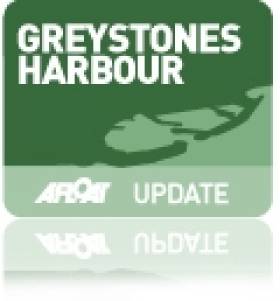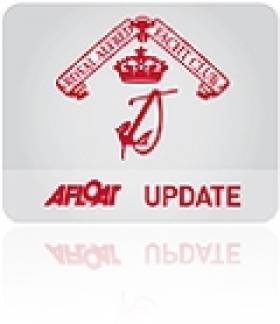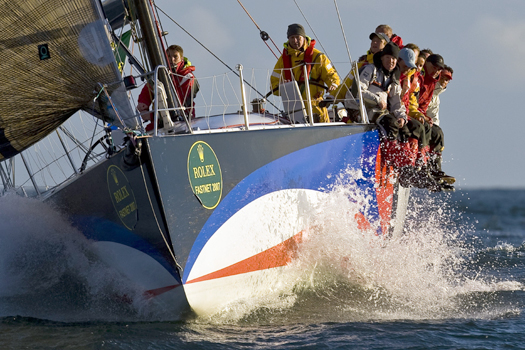Displaying items by tag: ISORA
2015 Sailing Calendar Includes Two Bicentenaries & Ireland's Biggest Regatta At Dun Laoghaire
Irishsailing – After the remarkable across-the-board success of the 2014 Irish sailing season, 2015 will have to be very special indeed to be remembered with such enthusiasm. But it's a special year in any case, as two major sailing Bicentenaries – one in the Irish Sea, the other in the Solent – will have added and poignant meaning, as the Centenaries a hundred years ago could not be celebrated because of the First World War.
As for Irish sailing generally, life moves on, there are new sailors on the water, successful young sailors are graduating to the next stage of their rapidly developing careers, and established stars continue to plan fresh campaigns, for sailing is indeed a sport for life.
Then too, new fixtures successfully introduced in 2014 will require nurturing, tuning and encouragement if they are to fulfil their potential in the coming year, while at the same time there's always extra effort needed to give proper support to established fixtures, which have to live with the reality that they might wilt through being taken for granted. Both new and longer-established boat classes will need continued enthusiastic involvement, and our well-loved classics and traditional craft must be cherished and sailed, for lack of use is the real enemy of boats, whether old or new.
As for the major administrative initiatives introduced in 2014, they will need constant monitoring, but deserve full support from the sailing and boating community at large, for it was in response to a grass-roots initiative that the radical and very necessary reforms of the Irish Sailing Association were undertaken. Those appointed to undertake the root-and-branch reform of the national authority have done so with commendable dispatch, so it is now the duty of the rest of us to support their continuing efforts. And we can best do that by enjoying our boats and our sailing and time afloat in its myriad of interests, while encouraging others to do the same. W M Nixon outlines on what the coming year may bring.
One thing at least is certain for the coming season afloat during 2015 in most of Europe. It will not mark any significant sailing Centenaries. Instead, we are immersed in four years of remembering the Great War of 1914-1918 a hundred years on, with all the added twists of that period's longer historical narrative in Ireland. In such a context, it may seem frivolous to point out that sports like yachting have no great Centenaries to mark at all in 2015. But this minor off-screen fact is a reminder of the all-involving horror and obscenity of total warfare on an industrial scale. It obliterated anything like normal life.
Yet as recreational sailing had been going on in some sort of organised form for hundreds of years – albeit in a fairly rudimentary way in its earliest years in the 16th Century – there may well have been several important dates to be marked during the time of the Great War itself, but they were allowed to pass as there was no sport afloat, while civilian life ashore was very subdued.
And in Ireland, with the Troubles persisting for four years after the end of the Great War until 1922, the Bicentenary of the Royal Cork Yacht Club in 1920 was to be a muted affair – the official History of the Royal Cork Yacht Club (published 2005) tells us: "Plans for a special dinner to celebrate the club's bicentenary in 1920 had to be cancelled, probably because of the disturbed conditions in the country"
So the idea of celebrating the Centenary of the Royal Yacht Squadron in Cowes in 1915 at the height of the international war - other than in a rather solemn shorebound way - would have been unthinkable. But that in turn fuels the celebrations when the peacefulgood times roll again. Thus the Royal Cork Yacht Club, having been unable to celebrate its Bicentenary in 1920, went on to have a fabulous two-year Quarter Millennium celebration in 1969-70. And as the RYS couldn't have a proper party in 1915, there's no doubt that the up-coming Bicentenary in 2015 will be the nucleus of international sailing's megafest-of-the-year.
There are of course several clubs which pre-dated the Squadron when it was founded in 1815. And there are many whose members outshine the small membership of the RYS in the breadth and energy of their sailing. But for 2015, let's just acknowledge that the prestigious Squadron has been at the heart of sailing history for a very long time, while their clubhouse's location right on the Solent at Cowes is so central that when any great Solent-related events are under way, the Squadron is in the middle of the story.
Thus it was on the Squadron lawn that in July that the Irish team celebrated their epic Commodore's Cup victory at the end of July 2014. And it will be towards the Squadron and its Bicentenary that the fleet will be racing in 2015's west-east Transatlantic Race. And then it will be the firing of the cannons from the historic Squadron battery which will signal the start of the 46th Fastnet Race on 16th August 2015.
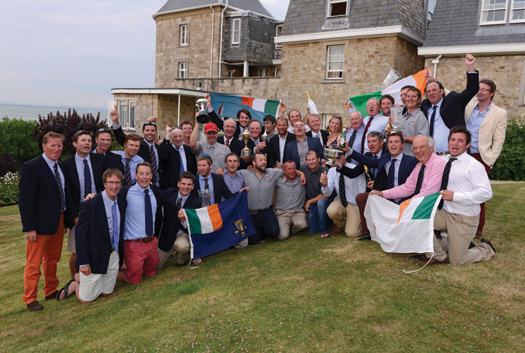
Party time at the Royal Yacht Squadron – the Irish team and their management gather to celebrate victory in the Commodore's Cup at the Squadron Castle in Cowes on August 1st 2014
There'll be many Irish boats involved, and the best-placed of them at the finish will be the winner of the Gull Salver, currently held by Martin Breen's Reflex 38 Lynx from Galway Bay SC, which was skippered to success by Aodhan FitzGerald in 2013's race. It's a coveted trophy, instituted to honour the memory of Harry Donegan of Cork and his famous cutter Gull, which was one of seven boats which inaugurated the Fastnet Race in 1925, and placed third. Since then, Irish Fastneteers have frequently been in the great race's top places, and best of all was in 2007 when Ger O'Rourke's Cookson 50 Chieftain out of Kilrush, sailing under the burgee of the revived Royal Western of Ireland YC, came sweeping in to the finish line at Plymouth to win the Fastnet Race
overall.
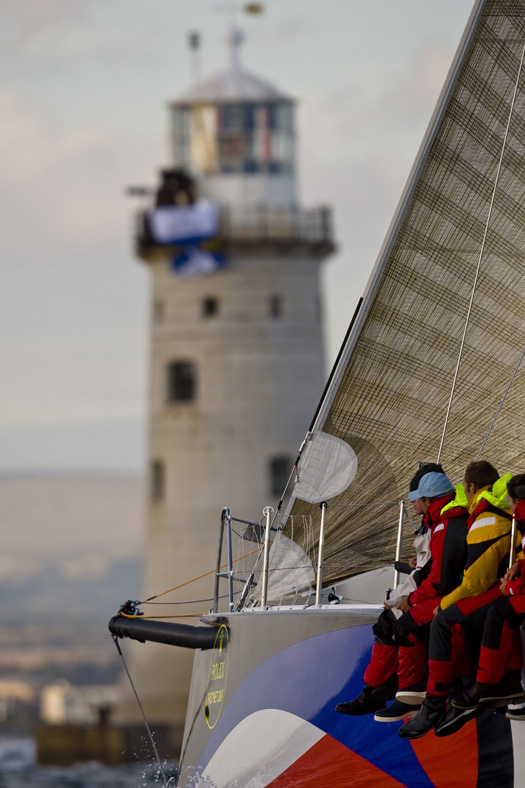
One of the greatest moments in Irish sailing history – Ger O'Rourke's Chieftain sweeps towards the finish line to become the overall winner of the Rolex Fastnet Race 2007. Photo: Rolex
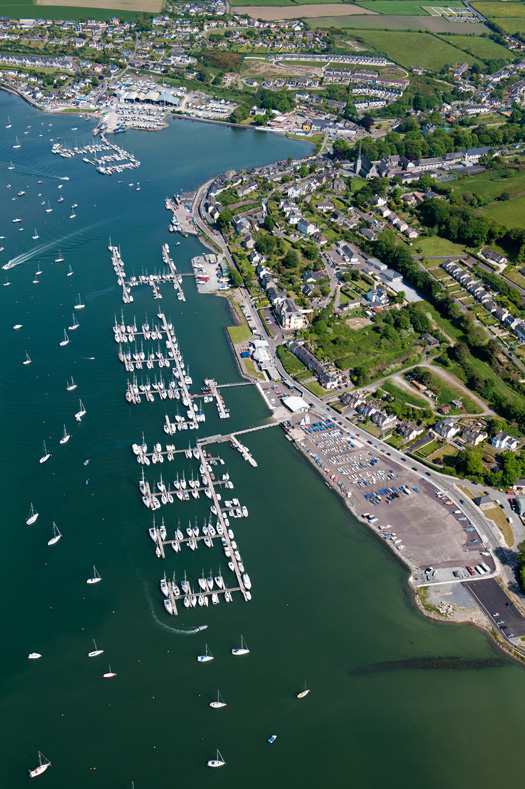
Just the spot for a great Tricentenary celebration - the very complete sailing facilities provided jointly by the Royal Cork Yacht Club and Crosshaven will become a world focus in 2020 with the Club's 300th anniversary. Photo: Bob Bateman
The realisation that 2015 sees this significant RYS Bicentenary is a timely reminder that the Royal Cork's Tricentenary is only five years down the line. They're five years which will be gone in a flash, and already behind-the-scenes moves are afoot to ensure that the national sailing programme will properly facilitate the extraordinary anniversary being celebrated in Crosshaven in 2020.
But meanwhile other Irish sailing centres have their own regular programmes to operate in the intervening four years, and in terms of numbers and scale there's no doubt the top event in Ireland in 2015 will be the biennial Volvo Dun Laoghaire Regatta from 9th to 12th July.
Anyone – and there were many - who took part in this unique "suburban sailfest" in 2013 will know that the VDLR has come of age. It's an event which is comfortable with itself while at the same time being always in development and evolution mode. Each staging of this remarkable Dublin Bay happening sees lessons being learnt and implemented even while the multi-class racing is under way on several courses. And in the two year gap before the next staging, the experience gained is closely analysed and the programme refined to further improve the sport in every area.
You get some idea of the sheer depth of racing experience in Dun Laoghaire by noting that the Chairman of the 2015 Committee is Tim Goodbody, with Martin Byrne as Vice Chairman while the Race Director is Con Murphy. And those three sailing megastars are just the peak of a mountain of race administration experience which is being drawn in from all over Ireland to ensure that the fleet of 400-plus boats gets the best sport possible.
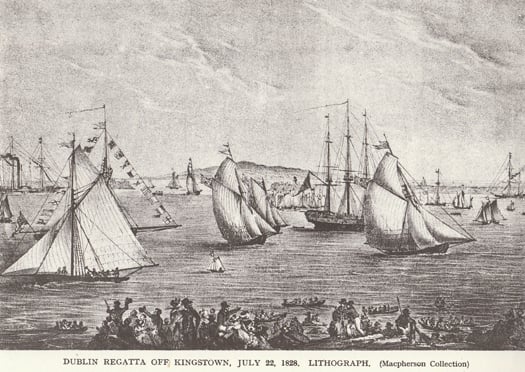
The first regatta in 1828 at the new harbour at Dun Laoghaire, which will be the setting for Ireland's biggest event in 2015, the Volvo Dun Laoghaire Regatta from 9th to 12th July.
While there'll be keenly participating boats from all over Ireland as well as Scotland, England and Wales, the setup of Dublin Bay being right on the city's doorstep means that it's the locals who would pose an administrative problem for a less experienced team. As the dates for the VDLR approached in 2013, the weather forecast steadily improved, and thanks to the Regatta's "extra long weekend" format, the sudden arrival of summer meant that a host of boats from the greater Dublin area came in as last minute entries, their owners and crews managing to scrape the extra day-and-a-half needed off work. It's a scenario which would put an overstretched administration off course, but the VDLR team took it calmly in their stride, and the result was a successful summer festival of sunlit sails and great sport, with maybe two thousand taking part.
This year there's a more structured cross-channel involvement, as the venerable Royal Dee YC in Cheshire has leapt to life to celebrate its Bicentenary. Founded as the Dee Yacht Club in 1815 with the end of the Napoleonic Wars, it didn't get the Royal seal until 1947, but nevertheless claims to be older than the RYS. With growing fleets in North Wales and the Mersey, it has put together a Bicentennial Royal Dee Irish Sea Offshore Championship linked closely to ISORA, which will bring the fleet across to Ireland to take in four offshore day races sailed as part of VDLR 2015.
Irish National Championships which will be part of the VDLR 2015 programme include the J/109s, the RS Elites, the Beneteau First 21s, and the Wayfarers, while the Leinster GP 14 Championship is also included as an integral part of the Regatta.
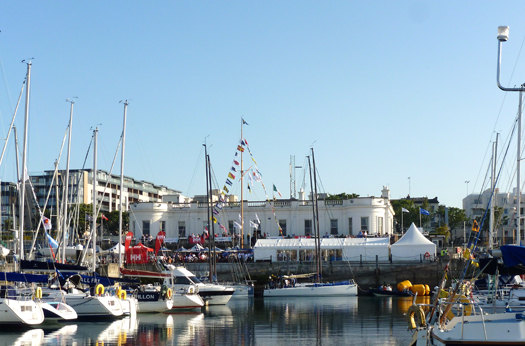
Party time in Dun Laoghaire – the Royal Irish YC during VDLR 2013. Photo: W M Nixon
As for Ireland's classic clinker-built vintage classes, one of the pleasantest surprises in VDLR 2013 was the large turnout of Mermaids, which had superb racing on the course area in the northwest corner of Dublin Bay. Despite having been born as the Dublin Bay SC Mermaid in 1932, this class of 17ft super-dinghies is no longer included in the regular DBSC programme owing to shortage of numbers for weekly turnouts. But it seems that as far as the VDLR is concerned, the Mermaid is now an event boat, and the fleets still thriving at other centres, together with some of the dormant Dublin Bay craft, bestirred themselves for the four days to enjoy good sailing for more than three dozen boats, something which is highly likely to be repeated in 2015.
The even more venerable Water Wags, founded 1887 with the current boats dating from 1903, continue to thrive in Dun Laoghaire, and the word is they expect to have at least twenty boats in action, while another wooden classic, the Mylne-designed 25ft Glen keelboat, is 50 years and more in Dun Laoghaire, and looks forward to having at least twelve boats racing in 2015.
All these specialized and historic classes are in addition to the numerous cruiser-racers which continue to be the backbone of Dublin Bay sailing. And while many of them will see the VDLR 2015 as a highlight of the year, in turning to consider the overall national programme, we find a sport which is shaking off economic recession to get on with an extraordinary plethora of local, national and international sailing events.
The problem is that most events of significance hope to locate themselves in the peak sailing period from late May to early September, so clashes are almost inevitable, and if you're interested in several different kinds of sailing, the overall choices can be bewildering in their complexity and logistical challenges.
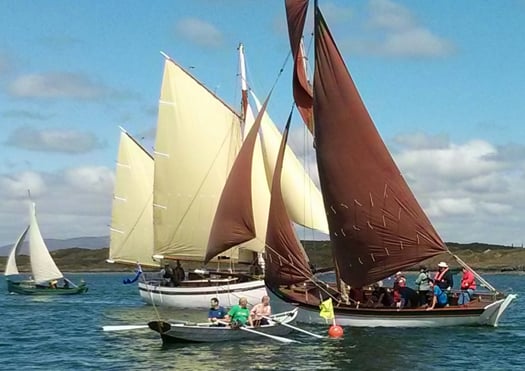
The Baltimore Wooden Boat Festival attracts an eclectic fleet – included here are a Shannon Gandelow, a West Cork Mackerel Yawl, the ketch Sile a Do, and an Heir Island Lobster Yawl (left).
For instance, the variety of events now available for the traditional and classic boats – usually but not necessarily under the Old Gaffer umbrella – would keep anyone busy for most of the summer. It starts with the Baltimore Wooden Boat & Seafood Festival from Friday 22nd May to Sunday 24th May, which you'd think very early
in the season for someone faced with fitting out an old wooden boat in Ireland's climate, but somehow they do it.
Then on the East Coast for the early summer Bank Holiday Weekend from May 29th to June 2nd, there's the Old Gaffer gathering in Dublin Bay at Poolbeg Y&BC with the annual race for the Leinster Trophy in the bay on Saturday May 30th, the event then morphs into the Dublin Port Riverfest in the Liffey on Sunday May 31st, and finally it all concludes with the race for the Asgard Trophy back in the bay on Monday June 1st.
The annual Lambay Race at Howth, a regular fixture since 1904, has seen its course becoming increasingly complex in modern times in order to satisfy the desire of modern racers for competition on every possible point of sailing. But in 2014, to celebrate the Centenary of the Lynch family's Echo, the venerable Howth Seventeens were sent on the traditional course north from Howth Harbour through the sound inside Ireland's Eye, then on round Lambay leaving it to port, and then back south inside Ireland's Eye again to the finish at Howth pierheads.
This was such an attractive proposition for Old Gaffers and Seventeens alike that on the day an extra Classics Division was added to cater for ancient craft, and it hit the spot. This option will be offered again for 2015's Lambay Race (it's on Saturday June 6th), and the word is that Dickie Gomes's 1912-built 36ft yawl Ainmara will be coming down from Strangford Lough to defend her title after 94 years. 94 years? Yes indeed - she won the Lambay Race in spectacular style in 1921 when still under the ownership of her designer-builder John B Kearney.
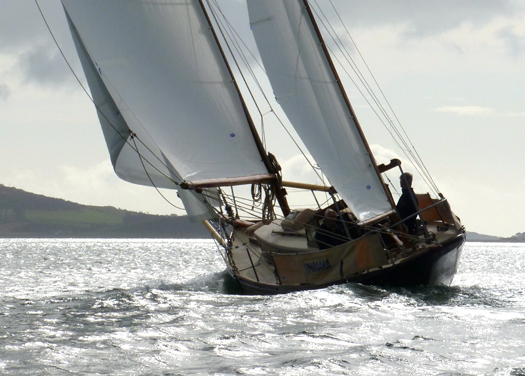
After 94 years, Dickie Gomes's 36ft 1912-built yawl Ainmara (seen here on her home waters of Strangford Lough) hopes to return to defend the title in Howth's Lambay Race, which Ainmara won in 1921 while still in the ownership of her designer-builder John B Kearney. Photo: W M Nixon
The Old Gaffers attention then swings north as the Tall Ships are coming to Belfast from Thursday 2nd July to Sunday 5th July. This is going to be a serious biggie with those ships already signed up including a significant turnout of Class A vessels, which are square riggers and others of more than 40 metres in length. Belfast Lough lends itself particularly well to the Parade of Sail which follows a Tall Ships gathering, and in 2009 when they were last in the port they put in in a virtuoso display with the Dutch ship Europa in particular going to the trouble of getting herself over towards Whiteabbey in the northwest corner of the lough to allow her time get every stitch of sail set before proceeding seawards down-lough in colossal style, a much more impressive display than we've become accustomed to in Dublin, where the shape of Dublin Bay is such that it doesn't really provide the space for square riggers to set all cloth before getting out to sea.
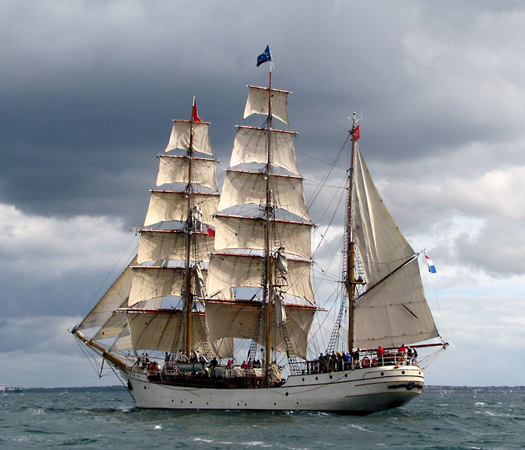
The Tall Ship Europa shows how it should be done in Belfast Lough in 2009, taking time out to set full sail before she starts to gather power to make the proper input into the Parade of Sail.
Like Dublin, Belfast has shown it can be hospitable to Old Gaffers, and it was a very welcoming main port during the OGA Golden Jubilee Cruise-in-Company in 2013, so for 2015 the OGA National President Sean Walsh hopes to up the ante by persuading his members from all round the Irish Sea to gather in Belfast, and to add spice to the mix, he hopes to persuade the Howth 17s to put in an appearance as well, to sail with local one designs like the 1903 Belfast Lough Waverley Class, which have been experiencing a revival in recent years.

Old Gaffers in Belfast for their Golden Jubilee in 2013. The Irish Sea classic and traditional fleet will return to the same venue for the Tall Ships gathering in July 2015. Photo: W M Nixon
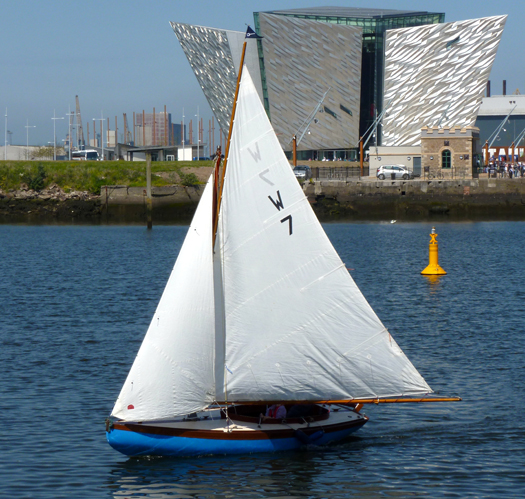
The Belfast Lough Waverley Class Lilias (built 1903) sailing at the Titanic Centre in Belfast. In 2015, the Waverleys will be joined by some of the 117-year-old Howth 17s to participate in the visit of the Tall Ships. Photo: W M Nixon
The Seventeens have made long treks as a class before – in 1998, five of them were road-trailed to Carrickfergus to mark the class's Centenary, with the first five boats built by Hilditch of Carrickfergus. So though they'd trailed there, they then sailed the 90 miles back to Howth, just as the first boats had done a hundred years earlier. Then in July 2003, fifteen of the Seventeens took part in the Glandore Classics Regatta thanks to a brilliantly organised exercise in logistics using a flotilla of low loaders which could take three boats apiece.
For all of Ireland's classic and traditional boats in 2015, and an international fleet too, Glandore is very much up on the radar again, as a special effort is being made by a GHYC team led by Donal Lynch to encourage increased numbers in the CH Marine Glandore Classic Regatta from Saturday July 18th through Friday July 24th. It's a date which certainly allows Old Gaffers plenty of time to get down from Belfast, indeed some may even consider the option of making the voyage northabout to take in a round Ireland cruise while they're at it. And as that great magnet of the Irish Sea classic and traditional scene, the Peel Traditional Boat Weekend, isn't until Friday 31st July to Sunday 2nd August, it's just about possible to factor that in as well.
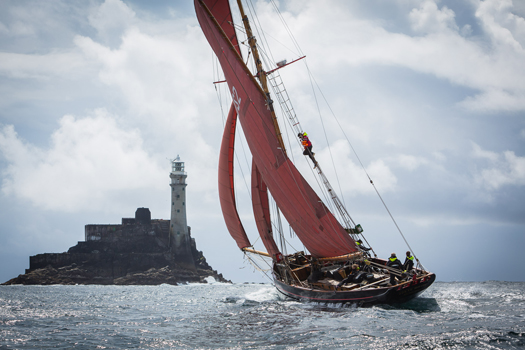
Everything happening at once – the famous Pilot Cutter Jolie Brise was the star of the Glandore Classics in 2013, and as it was her own Centenary she celebrated by sailing round the Fastnet Rock – she has been a successful Fastnet Race participant several times. Photo: Brian Carlin
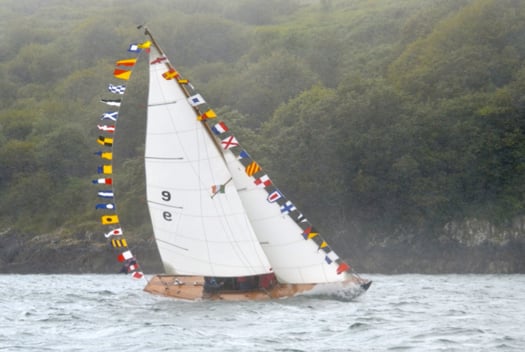
The Glandore Classics attracts an international fleet, and 2013's regatta included a class of Fife One Designs from the Menai Straits, all of them keen to party and showing it. 2015's Glandore Classics is from July 18th to 24th. Photo: Cormac O'Carroll
All this is already happening for the oldies with August barely under way, yet for modern cruiser-racers the potential programme for any keenly-sailed Irish boat is equally complex, attractive and challenging. The season starts as usual with the Scottish Series from Friday 23rd May to Monday 26th May – there'll probably still be snow on the mountains of Arran. They've gone back to their roots by starting with a feeder race from Gourock to the main regatta centre at Tarbert on Loch Fyne. "Going back to the roots" is something of a theme for this year's staging of the Clyde Cruising Club's main racing event, as this is the 40th Scottish Series. Come to think of it, there are so many important 40th anniversaries happening in sailing these days that we have the admit that the decade which brought us the full horror of wide lapels and flared trousers also contributed some lasting elements of the international sailing scene, indeed it could be said that the modern era in sailing really began about forty years ago.
Back in Ireland, the ISORA programme will be well under way by June, while the Lambay Race on June 6th can be looked at with more interest by several boats, as the biennial National YC Dun Laoghaire to Dingle Race doesn't start until Friday June 12th . Last time round, there was a total fixtures clash between the two events, but in times before that hyper-keen sailors such as the Tyrrells of Arklow with Aquelina have been able to fit in both, indeed one year they did it so well they won both too, and were rightly acclaimed as the Afloat "Sailors of the Month" for their success.
For 2015, defending champion in the Dingle Race is Brian O'Sullivan of Tralee with the veteran Oyster 37 Amazing Grace, which came good in the end in 2013 with a new breeze which knocked pending leader Antix (Anthony O'Leary) off the winning perch. But with the 2015 Dingle Race acting as a useful if rather indirect feeder for the Covestone Asset Management Sovereigns Cup in Kinsale from June 24th to 28th, there could be all sorts of sharp boats lining up to take the prize, for the Sovereigns Cup 2015 includes the all-singing all-dancing ICRA Nats 2015.

The welcoming port – Kinsale is one of Ireland's most popular destinations, and in 2015 its hosts the combined Sovereigns /ICRA Nationals from June 24th to 28th.

Perfect sailing – racing in the Sovereigns at Kinsale in June 2013. Photo: Bob Bateman
Yet the timing of the combined Sovereigns/ICRA Nats is such that there's still plenty of time and space to get back to the Irish Sea for the Volvo Dun Laoghaire Regatta 2015 from July 9th to 12th, a reminder that much of the cruiser-racer programme for 2015 is in a neatly balanced and user-friendly timescale for everyone except perhaps those who wish to do either the entire ISORA or SCORA programme as well, so the problem mostly is going to be getting time off work.
And for the hyper-keen cruiser-racers, particularly those whose boats are small enough to be conveniently trailerable, further temptation looms in 2015 with the WIORA Championship at Galway Bay Sailing Club from July 22nd to 25th. For the fleets in the Shannon, on Tralee Bay, and in Clew Bay, it's a bit more than a day's sail away, but they'll be there to challenge Liam Byrne of the home club who won it in 2014 with his Corby 25 Tribal at Mayo SC in Clew Bay, while some top boats from more distant centres are expecting to trail to Galway Bay to spice up the competition.
By this stage of the season a more relaxed pace might be welcome, but the lively turnout of 80 boats in 2014 for the new-style four day Cork Dry Gin Calves Week out of Schull in early August (Tuesday 4th to Friday 7th August in 2015) suggests that for racing sailors, the best relaxation is more racing, but in a holiday setting. And yes, it has been noted that a true West Corkian sailing nut could indeed do all of Calves Week 2015, and still be on the Squadron line for the start of the Fasnet Race nine days later.
For dinghies in 2015, the big story is the debut of the newest version of the National 18, and just how popular will the Bray-bult foiling Moths become, while established classes will frame their programmes to accommodate sailors whose time is limited, also having to fit in with a national scene where the number of Race Officers with the necessary skills is inevitably a finite amount.
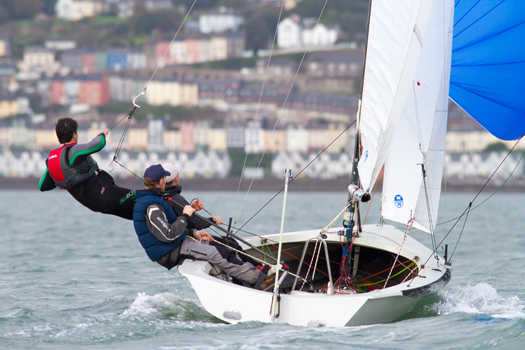
The big stories in Irish dinghy racing in 2015 will be the arrival of the new National 18s at Crosshaven, and the revival of Dinghy Week there in late August. Here, in the Autumn of 2013, To Dwyer and Nin O'Leary test sail the prototype of the new 18 on Cork Harbour. Photo: Bob Bateman
The new Third Generation (or maybe it's fourth or fifth generation) National 18 may have been designed in England by Phil Morrison, and is being built there too. But it was the very active Crosshaven fleet with the Royal Cork Yacht Club which led the charge towards a new boat, and when it came to stepping up to the plate to pay twelve substantial new boat deposits to move it all along after the prototype had been rigorously tested in Cork harbour last Autumn, it was the Crosshaven fleet that provided eight out of those twelve cheques.
So it's entirely appropriate that in August 2015, the dinghy focus will swing big time towards Crosshaven and a short form "Dinghy Week" from August 21st to 23rd. The old style Irish Dinghy Weeks – the last one was in 1970 – became victims of their own success, they just got too large. But the different classes became over-optimistic about their continuing individual growth prospects. Then the pendulum swung too far the other way, and dinghy classes were alone and their events shrinking. But a resurgence of club and championship dinghy sailing in Crosshaven during 2014, and a growing realization that over-reliance on single-handed dinghy classes does not necessarily produce a socially-adjusted national squad of junior sailors, resulted in some clear and creative thinking about developing two-handed boats, and reviving some old classes such as the Mirrors.
The form of this new Dinghy Week is still in the melting pot, but at least eight classes have responded with enthusiasm. Meanwhile, the National 18s in Crosshaven will be such a focus of interest during 2015 with the first of the new boats making their debut that we'll have a season-long dinghy narrative developing on Cork Harbour, and the revived Dinghy Week will be just part of it.
As for inshore keelboats, the big one in terms of number is the combined British and Irish Championship Squib Championship at Howth from 27th June to 3rd July. The handy little Squibs are something of an oddity, as they serve so well as a cherished local class in so many Irish sailing centres that many owners see them as that, and nothing more – handy little club sailors to be raced on home waters a couple of times a week.
This means that when a major regional or national event is held, the number taking part will often only be a fraction of the total Irish Squib fleet. But for those who do make the trek, the competition is fierce and the racing great – in Howth, the high point was in 1996, when this "Nationals" event attracted a fleet of exactly a hundred boats, and on one never-to-be-forgotten morning, there they were, every last one of them on the starting line.

A hundred Squibs all in a row at Howth on Tuesday July 25th 1996. Photo: Mandy Murnane
The most recent Squib event of national stature was the Freshwater Keelboat Regatta at Dromineer on Lough Derg on the weekend of October 18th-19th, and the battle for the top places was between the Kinsale and Belfast Lough fleets, with James Matthews and Rob Jacob of Kinsale rounding out their year in style with a good win.
But with the Squibs in England undergoing a revival – they were the second-biggest One Design fleet in Cowes Week 2014, bested only by the legendary XODs – there's no doubt there's a strong challenge coming across channel, and any Irish boat getting into the top ten will be doing well.
As for that annual Autumn Freshwater Keelboat Regatta at Dromineer, while it may have been much hampered by the spinoff from some ferocious weather out in the Atlantic with frustration for some of the sixty boats hoping to take part, it's an event of enormous potential, and the many who wish it well and have enjoyed it in the past will be ready and willing to do their part to make 2015's regatta a success.

The Squibs enjoying a lull in the strong winds during the Lough Derg Freshwater Regatta 2014. Overall winner was Mucky Duck (no 51, James Matthews & Rob Jacob, Kinsale YC). Photo: Gareth Craig
All these specialised and localized events planned for 2015 will be the continuing background music to the usual events of national sailing focus, everything from the selection of the Irish team for the Student Yachting Worlds to the Helmsmans Championships to the steady increase in pace while 2015 develops as the pre-Olympic year. As the year rolls along, other stories will develop too. So perhaps it's appropriate that we exit this review as we entered it. Just pause to remember now and again that, a hundred years ago, you simply couldn't have gone freely afloat like this for sport and recreation at all.
But we can't close on such a solemn note. Seasoned Solent sailors may have noted our header photo from Guido Cantini at the Panerai Classics Regatta was looking just slightly odd, for some reason difficult to pin down. Well, as it happens, the photo was sent to us back in September just as we were contemplating the excellent cleanup up done by Jason Hurley of Jason Hurley Design on the Mercedes-sponsored billboard photo of Howth 17s on the end wall of Howth Yacht Club. As with many photos taken over the RYS starting cannons, the Cantini pic included an obtrusive part of the Fawley Oil Refinery across on what Isle of Wight people call "the north island". Though Fawley has been there for yonks, it still has the look of a temporary structure. So we got Jason to treat as just that. But here for your edification is the true picture. You could get a taste for this sort of thing. What about brushing out Whitegate, lads? And as for Milford Haven.........
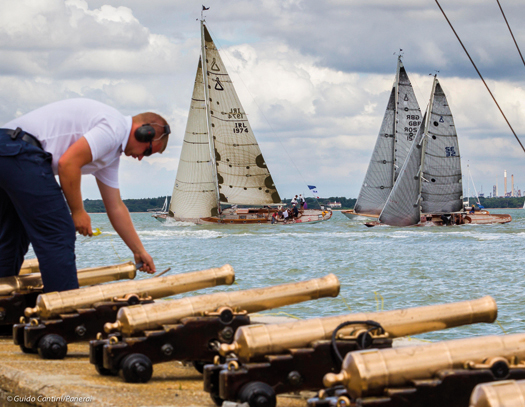
The unvarnished truth. In real life, the view from the RYS battery at Cowes can be slightly marred by the clutter of Fawley Refinery across the Solent on "the north island". Photo: Guido Cantini/Panerai
Read also: 2015 Irish Sailing Fixtures List (provisional)
Greystones Regatta Attracts ISORA Boats for 2015 Calendar
#isora – The weekend's ISORA AGM and black tie prizegiving at the National Yacht Club heard that subject to confirmation with Greystones marina it was decided that two ISORA day races would take place simultaneously from Dun Laoghaire and Pwllheli to finish in Greystones in County Wicklow on the day before the up and coming Greystones Regatta.
The new fixtures arrangement will bring up to 20 or more top class offshore racing yachts into the Greystones regatta fleet. The full ISORA race programme is available to download below as a PDF document.
ISORA chief Peter Ryan says the move designed to allow ISORA boats to partake in this new popular Wicklow event.
It was also decided to that the day races that start in Dun Laoghaire would not necessarily finish at the same venue but would finish in Wicklow or Howth, subject to weather conditions.
It was agreed to run 14 races as part of their series next season – 6 traditional cross channel races including the RORC Lyver Race and an offshore weekend that will include a Friday evening race from Holyhead to Douglas, Isle of Man and another race on the Sunday morning from Douglas to Dun Laoghaire.
The Dun Laoghaire to Dingle Race will also be part of the ISORA Series.
Shanahan's 'Ruth' Crew Crowned ISORA Champions at National Yacht Club Prizegiving
#isora – ISORA held its annual prizegiving dinner dance at the NYC on Saturday 15th November. 171 members and guests packed into the dining room of the club to be treated to a superb night's dining and entertainment.
ISORA's guests at the event were Larry Power, Commodore of the National Yacht Club, Derek Matthews, Commodore of the Royal Dee Yacht Club and Barry MacNeaney, Commodore of the Royal Alfred Yacht Club.
The MC for the evening was Peter Ryan, Chairman of ISORA, who directed the traditional toasts made by each of the guests and Andrew Hall, past Chairman of ISORA. Due to the numbers of people in the dining room the Royal Navy tradition of not standing for the Loyal Toast to the "President of Ireland" was invoked. It was also noted that the Royal Dee YC will be celebrating their 200th anniversary next season and that between the three clubs present at the dinner, it represented 501 years of sailing existence!
Anne-Marie Ryan presented the numerous trophies and prizes to the members. The winner of the Overall ISORA championship for 2014 was Liam Shanahan and "Ruth". Liam was presented with the coveted "Wolf's Head" trophy by the Commodore of the Royal Dee YC, whose emblem is the "wolf's head". ISORA sailors and recent successful Round Britain & Ireland Race two-handed class winners, Liam Coyne and Brian Flahive were presented with ISORA's "Penmaen Plate", a trophy dedicated to a past Chairman of ISORA, Anthony Jones, and award to that member that has most exhibited the "Spirit of ISORA". Pwllheli Sailing Club won the Team Prize.

Anne-Marie Ryan presenting the "Penmaen Plate" to Round Britain & Ireland Sailor. Liam Coyne. Photo: GP Foto
Other awards included a presentation to the Manx Sea Scouts who marshalled and looked after the ISORA fleet during their visit to the Isle of Man during the season.
At the dinner Commodore Derek Matthews of the Royal Dee YC announced that in celebrating their 200th anniversary next year they were organising, in conjunction with ISORA, the Royal Dee Irish Sea Offshore Championship next season. It will be a championship using offshore courses and will consist of the RORC Lyver Race from Holyhead to Dun Laoghaire and the four Offshore Races as part of the Volvo Dun Laoghaire Regatta. The event, while part of the VDL Regatta, will be based in the NYC.
.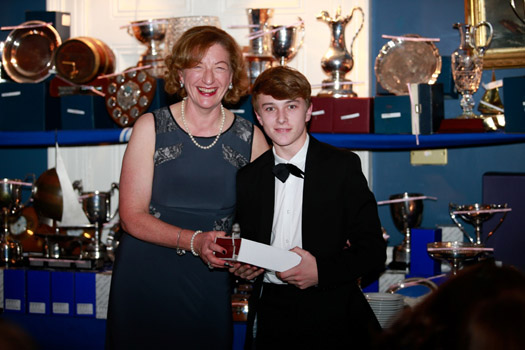
Anne-Marie Ryan presenting an award to Manx Sea Scouts for "Services Rendered" Photo: GP Foto
Earlier at the well attended ISORA AGM it was agreed to run 14 races as part of their series next season – 6 traditional cross channel races including the RORC Lyver Race and an offshore weekend that will include a Friday evening race from Holyhead to Douglas, Isle of Man and another race on the Sunday morning from Douglas to Dun Laoghaire. The Dun Laoghaire to Dingle Race will also be part of their Series. Subject to confirmation with Greystones marina it was decided that two Day races would take place simultaneously from Dun Laoghaire and Pwllheli to finish in Greystones on the day before the Greystones Regatta. This will allow those boats to partake in this new popular event. It was also decided to that the day races that start in Dun Laoghaire would not necessarily finish at the same venue but would finish in Wicklow or Howth, subject to weather conditions etc.
Other issues discussed and agreed at the AGM that ISORA would continue its practice of specifying a mandatory Safety requirement in accordance with the ISAF Offshore Special Regulations.
J/109 Ruth Wins Royal Alfred Yacht Club Coastal Series
#rayc – The Royal Alfred Yacht Club (RAYC) Coastal Series out of Dublin Bay provided a nail-biting finish to the silver fleet outcome with only one point separating first and second places overall. Full results are downloadable below.
Pippa IV and Yahtzee, despite only sailing in three of the four races, organised jointly with ISORA, and thereby not having the cushion of a discard were on equal points going into the last race of the Series. Pippa IV shaded it in the final tussle and emerged the victor.
In the Gold Fleet, following Jedi's success over the last couple of years with Liam Shanahan's Ruth nipping at his heels, it was the turn of Ruth to take the Trophy and round off a great year for the Liam Shanahan crew.
Shanahan's J109 Ruth Wins ISORA 2014 Championships
#isora – The National Yacht Club's top offshore yacht Ruth skippered by Liam Shanahan, that came within minutes of claiming the Round Ireland Race in June, has confirmed her overall win of the 2014 ISORA Championship following the race from Pwllheli to Dun Laoghaire yesterday. Overall results are downloadable below as a jpg file.
A J109 sistership, Mojito, won yesterday's ISORA race ten sponsored by Hendrick Ryan and Associate which featured six J boats taking the top five positions.
Overall, J109s also took the top three places with yesterday's winner the runner–up. Third was Mojito's Pwllheli club–mate Sgrech, the Stephen Tudor skippered 2013 champion.
Additional reporting by Peter Ryan below
The overall championship was decided at the last race when Liam Shanahan's "Ruth" crossed the finish line after the Hendrick Ryan + Associates "James Eadie" Pwllheli to Dun Laoghaire race on the 6th September. Fifteen boats came to the start line in Pwllheli. Of the line-up, six of the boats were "J" boats and of them five were J109's.
The forecast was for northerly winds all day ranging from 10-15 knots. At the start the wind was 10 knots and this sped the fleet down to the PSC racing Mark No 2 and then direct to Dun Laoghaire. "Jackknife" was the first to break away and was soon far out in front ahead of the five J109's. The fleet had just 2 hours to get to Bardsey or the tide would turn south against them. "Jackknife" just arrived at Bardsey as the tide was turning but the gate was firmly closed by the time the remainder of the fleet arrived. Not only that but the wind dropped.
In an effort to get out of the tide most of the boats attempted to stay as close as possible to the land side of the sound but unfortunately, there was no wind there. The lack of wind and the tide bunched the fleet, with the exception of Jackknife". The race re-started again when the winds filled in and "Mojito" led the charge out of the sound. "Predator" retired in Bardsey after storming through the stationary fleet.
The leg to Dun Laoghaire should have been a tight reach but the wind backed to the north-west and continuously veered and backed all day. All the remaining "J" boats with the exception of "Jedi", who had to retire at Bardsey, were bunched together as they headed across the Irish Sea. Seconds only separated them and there was little change in position over the remaining 57 miles.
With the winds veering and backing, the fleet just made it into Dublin Bay. "Sgrech" maintained a more northerly course and looked to be in a good position however "Mojito" managed to squeeze up and cross the finish line less than 2 minutes ahead of "Sgrech" to take the Overall and Class 1. Although "Jackknife" had finished an hour and a quarter before "Mojito", it was not enough to give them the race. "Adelie" took Class 1 while "Big Deal" took the Silver class.
"Ruth" only managed a third Overall but they did enough to take the Championship and the "Wolf's Head Trophy". They also won Class 1. "Adelie" took Class 2 while "Big Deal" took the Silver class.
The fast race meant that all boats had finished by mid-night allowing all the crews to gather in the NYC for the end of year party.
The prize giving will take place at the annual dinner in the NYC on the 15th November. The AGM will also take place that day. As normal, the race schedule for 2015 will be decided at the AGM. Suggestions for races are being sought and all should be sent to me at [email protected] . The dinner is always very popular and I would recommend that places be booked as soon as possible with the Manager in the NYC, Tim O'Brien, [email protected] .
It was the end of another great season of very mixed weather conditions. The season also produced two outstanding offshore performances by ISORA members. Liam Coyne and Brian Flahive's "Lula Belle" taking Class and 6th Overall in the recent Round Britain & Ireland Race and our new champion, Liam Shanahan and "Ruth" taking second place in the Round Ireland Race. ISORA are really proud of them.
Peter Ryan - Chairman
Go LulaBelle! How Ireland Won The Round Britain & Ireland Race
#rorcsrbi – For twelve days, Ireland's sailing and maritime community followed with bated breath while the fortunes of Liam Coyne and Brian Flahive with the First 36.7 Lula Belle waxed and waned in the storm-tossed 1802-mile RORC Sevenstar Round Britain & Ireland Race. Last Saturday, they triumphed, winning the two-handed division and two RORC classes in this exceptionally gruelling marathon. W M Nixon delves into the human story behind the headlines of success.
It used to be said that Irish seamanship was the skilled and stylish extrication of the vessel from an adverse and potentially disastrous situation in which she and her crew shouldn't have been next nor near in the first place.
While we may have moved on a bit from that state of affairs with a less devil-may-care approach to seafaring, there's no escaping the fact that this morning we can now look back at two remarkable Irish victories in topline international offshore events in recent years in which both crews overcame major setbacks and situations, rising above very adverse circumstances which could well have deterred sailors from other cultures where the philosophy is not underpinned by the attitude: "Ah sure lads, things aren't good. Not good at all. But let's just give it a lash and see how we go".
It was seven years ago when a full entry list of 300-plus boats was slugging westward down the English Channel in the first stages of the Rolex Fastnet Race 2007. Already, the start had been postponed 24 hours to allow one severe gale to go through. But in an event still dominated by the spectre of the 15 fatalities in the storm-battered 1979 race, most crews were hyper-nervous about another gale prospect, and by the time the bulk of the fleet was in the western English Channel, many succumbed to the allure of handy ports to lee such as Plymouth, and in those early days of the race something like 48% of the fleet retired.
But aboard Ger O'Rourke's Cookson 50 Chieftain out of Kilrush on the Shannon Estuary, they were well into their stride. That year, the boat had already completed the New York to Hamburg Transatlantic Race, placing second overall. But owing to her Limerick owner's quirk of never confirming the boat's entry for the next major event until the current one is finished, they found themelves only on the waiting list for that year's already well-filled Fastnet Race entry quota.
Chieftain was 46th on that list. Yet while those who had made an early entry fell by the wayside, steadily this last-minute Irish star rose up the rankings. With three days to go, Chieftain got the nod. They went at the racing after the delayed start as though this had been a specific campaign planned and carefully executed over many months with a full crew panel, instead of a last-minute rush where crew numbers were made up by a couple of pier-head jumpers who proved worth their weight in gold.
Yet then, as the new strong winds descended on the fleet as the group in which Chieftain was already doing mighty well was approaching the Lizard Point, the troubles started, with gear failing and boats pulling out left and right. But the Irish boat was only getting into her stride. A canting-keeler, she could be set up to power to windward in a style unmatched by bigger craft around her. Approaching the point itself in poor visibility to shape up for the fast passage out to the Fastnet Rock with even faster sailing, things looked good. And then the entire electronics system aboard went down, and stayed down.
Here they were, not even a third of the way into a race which promised to be rough and tough the whole way, but a race in which they would at least have been expecting know their speed, performance and position down to the most minute detail. Instead, they were in an instant reduced to relying on a couple of tiny very basic hand-held GPS sets, and paper charts.
Ger O'Rourke's Chieftain sweeps in to the finish at Plymouth to win the 2007 Rolex Fastnet Race overall
Those paper charts were little better than pulp by the end of a very wet race in an inevitably extremely wet but searingly fast boat. But they did get to the end, and with style too. They won overall and by a handsome margin. It was the first-ever Irish total victory in the Grand National of Ocean Racing. The owner-skipper had to go up the town to buy himself a clean shirt for the prize-giving in the Plymouth Guildhall.
Yet when Ger O'Rourke's Chieftain swept into Plymouth and that triumph just over seven years ago, the boat was in much better racing shape than Liam Coyne's First 36.7 Lula Belle when he and Brian Flahive completed the final few miles back into Cowes around midday last Saturday to finish the 1802-mile Sevenstar Round Britain & Ireland Race.
Lula Belle had many gear and equipment problems after an extreme event where the natural pre-start nervousness had been heightened by a reversal by the Race Management of the originally clockwise course as the 10th August start day approached. It would have been folly to send the fleet westward into storm force westerlies in restricted waters. Eastward was the only sensible way to go.
Then the arrival of the remains of Hurricane Bertha – which seemed to be finding new vigour – led to new tensions with the start being postponed from midday Sunday to 0900 Monday. It was disastrous from a general publicity point of view. But it would have been irresponsible to send a fleet of boats – some of them mega-fast big multihulls – hurtling towards the ship-crowded narrows of the Dover Straits beyond the limits of control in a Force 11-plus from astern.
Even when they did race away, it was with a Force 8 plus from the west, with the Irish crew recording 42.5 knots of wind aboard Lula Belle (and from astern at that), before they lost all their instruments from the masthead on the first night out. For a double-handed crew, that was a very major blow. Two-handers are allowed to use their auto-pilot, and if all the wind indicators are functioning in proper co-ordination with it, then the boat can sail herself along a specific setting on the wind. It's as good having at least one extra hand – and a skilled and tireless helmsman at that - on board.
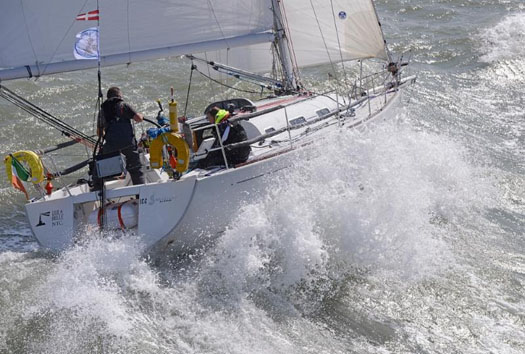
Lula Belle on her way out of the Solent with 1800 miles to race and everything still intact. Photo: Rick Tomlinson
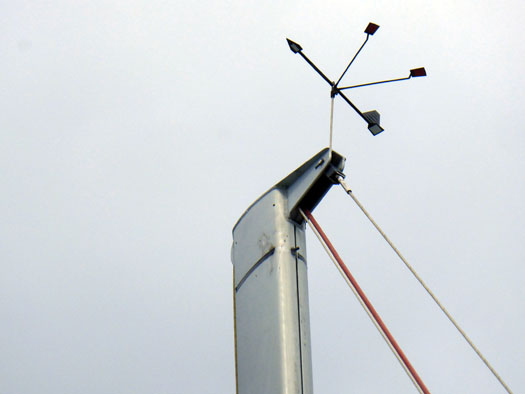
There it was – gone. After the first night at sea, Lula Belle's masthead was bereft of everything except an often defective Windex. Photo: W M Nixon
Fortunately the auto-pilot itself was still working on its own, and they became well experienced in setting the boat on course and then trimming the sails to it in a continuous process which worked well except when the seas were so rough and irregular that they had to hand steer in any case, albeit with the apparent wind indicated only by the sole survivor of the masthead units, the little standard Windex. But it must have been damaged when everything else was swept away, as from time to time it jammed. When that happened, the only wind indicators available to the two men were the Sevenstars battleflag on the backstay, the tell-tales on the sails, or a moistened finger held aloft, as neither were smokers.
Despite this, they made their way north through the North Sea and all round Scotland and its outlying islands and right down the western seaboard of Ireland as far as the Blaskets before things went even more pear-shaped. In fact, the wheels came off.
Their ship's batteries had been showing increasing reluctance to hold power, essential for the continuing use of the autohelm and the most basic need for lighting and any still-usable electronic equipment including the chart plotter. But thanks to a trusty engine battery, they could start the motor to bring the ship's batteries back up to short-lived strength. Yet while approaching the Blaskets, the engine refused to start, and nothing they could do would coax it back to life. Inevitably they lost power, and for the final 495 miles of the race – the equivalent of 78% of a Fastnet Race - the boat was sailed and navigated entirely manually, with the required navigation lights provided by modified helmet lamps.

The chart plotter shows only too clearly where power was lost completely just north of the Blaskets. Photo: W M Nixon
Yet they finished well last Saturday, around noon on August 23rd after twelve days racing. They won the two-handed division overall, they won Classes IV & V, and they placed sixth overall in a combined fleet in which big boats with a strong element of professional crewing dominated. So who are Liam Coyne and Brian Flahive, and what about Lula Belle, the heroine of the tale?
Afloat.ie caught up with them on Thursday morning in Dun Laoghaire marina, where they'd got home an hour or so before dawn to grab a quick sleep of a few precious hours before awakening to more sunshine than they'd experienced for a long time, as the Round Britain & Ireland was raced across an astonishingly sunless sea. As for the 450-mile passage home to Dublin Bay, it had been achieved through mostly miserable weather and an enforced and brief stop in Plymouth to try to get a final solution to the continuing electric problems, which had defeated the finest minds in Cowes.
But such hassle fades when the return home is completed, and the Lula Belle crew were in great form. They complement each other. Brian Flahive is from Wicklow and he's a studious, thoughtful type. He turned 31 just three days after the win, making it his best birthday ever, and a fitting highlight in a sailing CV which continues to develop, and began with local sailing and training courses with Wicklow Sailing Club after his sister Carol had acquired a Mirror dinghy.
Since then, Carol's seagoing has taken a slightly unexpected turn as she found her vocation in the lifeboat service, and that is now her main interest afloat - she is a helm on the Wicklow lifeboat. But her younger brother Brian was soon hooked on pure sailing, and from the Mirror he soon went on the 420s where his enthusiasm was noted by local keelboat owners, who in turn recruited him aboard, and soon he was noted by those assembling offshore racing crews too.
When you've talent, enthusiasm and time available, the word soon gets about in the limited recruiting pool available to Ireland's offshore racing folk. Soon, young Flahive was spreading his wings with his home port's biennial Round Ireland race, and participation in Irish Sea Offshore Racing. He proved adept at and interested in two-handed sailing in particular, and soon got to know another relative newcomer to the Irish Sea offshore racing scene, Liam Coyne.
Liam Coyne is 47, and something of a force of nature. There's a mischievous twinkle to his eye, but there's a very serious side to him too, even if – as when he admits he's extremely competitive – it's done in the best of humour. He's from Swinford in County Mayo, where any knowledge of boating might relate to the big lake of Lough Conn nearby. But as he left Mayo for the USA just as he was turning 20, his passionate sailing involvement has been entirely generated during his more recent life in Dublin.
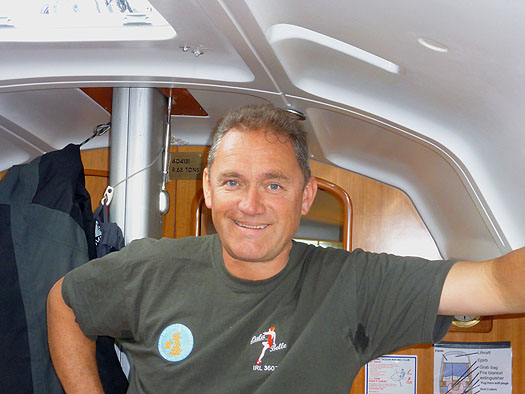
There's a mischievous twinkle, but Liam Coyne makes no secret of his competitive nature. Photo: W M Nixon
Back in the 1980s, well before Australia took off as the destination of choice for energetic and ambitious young Irish people, America was still the Land of Dreams. Coyne's teacher of English in Mayo was so sure of this that one of his courses was built entirely around the USA's immigration examination. He did a good job, young Coyne made the break, and he started to fulfill his ambition of getting to all the American states by spending time – sometimes quite a lot of it – in 26 of the States of the Union. Eventually with a winter approaching, he found the building site he was quietly working on in Boston was due to close completely for the colder months. But he managed to swing a job selling Firestone tyres (sorry, "tires") from the local agent's shops. It was a union created in heaven. Liam Coyne and tyres – the bigger the better – were made for each other.
He prospered in the tyre business in Boston and enjoyed his work, but there was always the call of home and a girl from Swinford who had qualified as a teacher. So he came back to Ireland in 1998, set up in the tyre business in Leinster, married the girl and settled down in south Dublin to raise a family.
Came the boom years, and the tyre business prospered mightily. Liam Coyne Tyres had five depots and employed 48 people. He was mighty busy, but seeking relaxation. So on the October Bank Holiday Monday in 2005, he and his wife went to the Used Boat Show at Malahide Marina and by the time they left, Alan Corr of BJ Marine had sold them a handy little Beneteau First 211, their first boat.
His knowledge of boats and sailing was rudimentary to non-existent. His maiden voyage, the short hop of 12 miles from Malahide to his recently-joined new base at Poolbeg Y& BC in Dublin port, took all of 14 hours as the tyro skipper battled with the peculiarities of tide and headwinds, happily ignoring the potential of the little outboard engine on the transom even though, as Alan Corr cheerfully told him later, it could have pushed the boat all the way to Arklow in half the time.
But he was enchanted by this strange new world, and the camaraderie of the sailing community as expressed in Poolbeg. He made a tentative foray into the club's Wednesday night racing, and was even more strongly hooked. But even though those Wednesday club races in the inner reaches of Dublin Bay were such fun that from time to time he still returns to race with his old clubmates at Poolbeg, he knew that his ambitions would dictate a move into a larger boat, and the bigger world of Dublin Bay sailing. So when the next Dublin Boat Show came along, he went to it and ended up buying a Bavaria 30 from Paddy Boyd, who was marketing Bavarias in the interval between being Secretary General of the Irish Sailing Association, and Executive Director of Sail Canada.
Paddy Boyd wised him up to the Dun Laoghaire sailing scene, and which club he might find the most congenial while being suited to his ambitions. For Liam Coyne was discovering offshore racing, and particularly the annual programme of the Irish Sea Offshore Racing Association. He liked everything about ISORA, the friendships, the willingness to help and encourage newcomers, and the pleasant sense of a mildly international flavour between the English, Welsh and Irish contingents.
One of his fondest memories is of taking his Bavaria 30 across to North Wales for the annual Pwllheli-Howth race which traditionally rounds out the season, and is often blessed with Indian summer weather. As he headed away from Dublin Bay, he suddenly realised it was the first time he had ever left Ireland under his own command. All previous exits had been on scheduled ships or planes. It was a very special moment.
Yet while he treasures the memory of such special moments, it wouldn't be Liam Coyne if he wasn't moving on. He'd relocated his base of operations to the bigger scene of the National Yacht Club and Dun Laoghaire, and developed his taste for double-handed offshore racing and its link to a group whose only common denominator seemed to be that many of them shared an enthusiasm for racing vintage Fireballs in Dun Laoghaire harbour in the winter.
But in the summer, keelboat offshore racing with just two on board was increasingly their main line, and he was soon on terms of friendship with the likes of Brian Flahive, Barry Hurley and others, while the double-handed class in events like the Dun Laoghaire-Dingle, the Round Ireland, and the Fastnet itself were coming up on the radar.

The newly-acquired First 36.7 which became Lula Belle greatly broadened the scope of Liam Coyne's offshore racing. Photo: W M Nixon
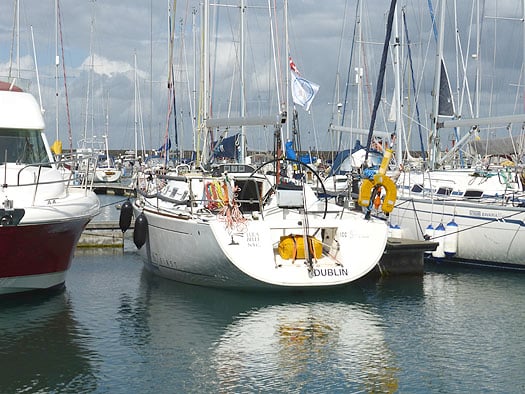
The First 36.7 is of a useful size to be a very pleasant family cruiser, but Lula Belle has been a multi-purpose boat since Liam Coyne bought her, with the emphasis on double-handed offshore racing, and the longer the course, the better. Photo: W M Nixon
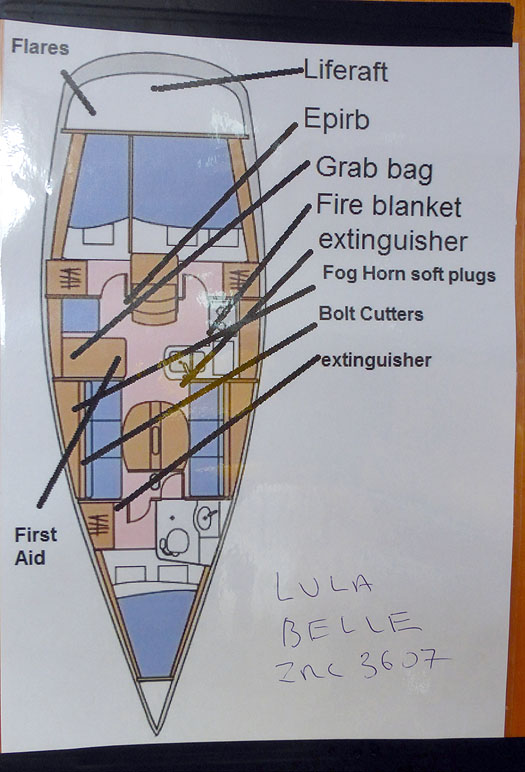
Lula Belle's layout - the accommodation of a cruiser/racer with extras installed for serious offshore racing, but for proper cruising they'd also be required. Photo: W M Nixon
Having made his mark offshore partnered with Brian Flahive on the Bavaria, he very quickly moved up to the almost-new First 36.7 Baily, bought from Tom Fitzpatrick of Howth. His name of Lula Belle for the boat was inspired by a recently-deceased aunt who had invariably addressed all of his sisters as "Lula Belle" when requesting something like a cup of tea. It's certainly a distinctive name, and it was beginning to feature regularly in short-handed and fully-crewed offshore racing reports when Ireland fell off the economic cliff around 2007.
The tyre business was hit particularly hard, for they're items whose replacement people can try to avoid by shifting used tyres around on and between vehicles to get the last piece of tread usable. But fortunately, one of his key contracts was in the heavy industrial area, where they use tyres so big your everyday motorist has no notion of them, yet legal safety working requirements dictate their regular replacement.
Despite this, at one stage his fine workforce of 48 had become effectively just two, while three of the five depots were closed. "I can tell you" he says, "there were times when we were glad enough the wife had kept her teaching job". And they were raising a family, eventually with three kids with a much-loved holiday home at Enniscrone in southwest Sligo. Then too he had this 36ft racing boat too. Yet all his fine assets and the value of the family home in Dublin had effectively been slashed by at least 50% and often more.
But somehow he kept going, and he even continued to race offshore. By this time one of the leading figures in the Irish short-handed sailing scene, Barry Hurley, had moved to Malta, and when he was recruiting crew for a friend with a Grand Soleil 40 for the annual 620-miles Middle Sea Race from Valetta in late October, he filled four berths with able-bodied crew from Dublin including Barry Flahive and Liam Coyne.
That race brought something of another epiphany to match that moment of pure joy at realizing he was skippering his own boat out of Irish waters for the first time. They'd come through the Straits of Messina eastward of Sicily, and next turn of the course was the volcanic island of Stromboli. It was a blissfully warm summer's night, and Liam was at the helm in just shorts and shirt, enjoying the sail and revelling in the race.
Stormboli was gently erupting just enough to show it was there, and ideal to be a mark of the course. "I'll tell you," says Liam, "it was a very long way indeed from your usual October night in Swinford". The magic of the moment reinforced his ambition to see his business through the recession and out the other side, which he has now achieved with busy depots in Navan and Dublin, and staff back above the twenty mark. Yet oddly enough, it also reinforced a shared ambition with Brian Flahive to do the four-yearly Seven Stars Round Britain & Ireland Race, when conditions up in the northern seas off Shetland and across towards the Faroes can often make an October night in Swinford seem like the balmy Mediterranean by comparison.
But the idea just wouldn't go away, and they put down their names for the 2014 race. With the economy coming out of intensive care and two good managers running his two depots and the three kids though the very young stage, Liam Coyne felt he could take off the time for this major challenge. But even so it was done without any form of shore management support, and in fact he managed to mix it with some family cruising – to which the boat is surprisingly well suited – by taking his young son Billy (10) and daughter Katie (8) along with him for a leisurely delivery to Cowes by way of many of the choice and picturesque ports along the south coast of England, where his wife and the youngest child joined the party to see them off.
That was in the last of the summer. By the time the starting date was upon them, it was as if a giant and malevolent switch had been activated. The weather was horrible, and even when Bertha had finally grumbled along on her way, it was anticipated that the rush of bitterly cold north winds she'd drag down from the Arctic in her wake would be every bit as unpleasant.
Then came the complete reversal of the course, and the postponement of the start. For a crew who were being their own shore managers and technical support team, it added a last minute mountain of research work on the shape the weather might be when they finally got away, and all the mental strains of waiting overnight for the start. As the lowest-rated boat in the entire fleet, they may have had the consolation of knowing that if they finished with just one boat behind them then they wouldn't be last on corrected time. But by being the low-rater, they would probably finish so long after everyone else that any general celebration would be long over.
That said, when a double-handed team have already successfully bonded, they're better at withstanding the strain of an enforced wait for a delayed start than a larger crew. I can remember only too well when the RORC Cowes to Cork race of 1974 was postponed for ten hours by the then RORC Secretary Mary Pera. A Force 10 sou'wester was making the Needles Channel a complete maelstrom on the spring ebb, but it was forecast soon to ease, so we were to be sent off on the evening ebb.
To get through the wait, it seemed best to stay well away from the boat and have a quiet day if at all possible. But aboard the 47-footer on which I was sailing, there were action men who decided it was time for a party lunch. So although I slunk away alone up the back streets of Cowes (Kensington-on-Sea it was not), and found a little café where the owners were persuaded to provide lunch of boiled potatoes and steamed fish instead of the usual nausea-inducing fish'n'chips, back on the waterfront others meanwhile had different ideas. A massive former rugby international in our crew decided the best way to pass the time was a champagne reception in one of the Cowes clubs followed by a bibulous lunch, and he persuaded several shipmates to join him, though they were circumspect in their consumption while he went at it as though it would be the last festive lunch in his life.
When we finally got racing the wind had indeed eased, though things were still rough enough in the Needles Channel, where we slammed into a head sea with such vigour that the Brookes & Gatehouse speedo impellor – normally a particularly stiff-to-move bit of equipment – was shot into its hull housing so totally we assumed it had broken entirely. It took a few seconds to realize what had happened, and it worked again happily enough once it had been pushed back into working position with the usual robust heave.
However, our mighty rugby forward was not so happy. He was not a happy budgie at all. The news is that, though you may be battering along noisily but successfully with endless bangs and squeaks and groans of one sort or another, when an international rugby forward of classic size gets massively seasick, a new dimension enters the sound and vibration scene - it's as if the entire boat is shuddering from end to end.
But enough of that. In Cowes on the morning of Monday August 11th 2014, it was still blowing old boots from the west , but they tore away downwind like there was no tomorrow. And for some, as far as racing was concerned, there wasn't. Any tomorrow, that is. There were several overnight retrials that set out to be temporary but became permanent. Aboard Lula Belle, however, they were still going strong, but after recording that gust from astern of 42.5 knots (which meant it was pushing 50), the masthead broccoli decided it had had enough, and made its exit.
Some time long before the race, Liam had decided he'd ensure the minimum use of power by having a LED tricolour masthead light, and a technician had been sent aloft to fit it. But that first night, it took off on its own, but taking much else with it, and leaving a beautifully clean masthead, but damn all information for those down below other than a Windex with an increasing tendency to jam.
And already the sails were suffering, for although their gybes were hectic enough, they didn't have to worry about check-stays or runners. But the downside of that was the well-raked spreaders, which helped support the mast in the absence of any aft support rigging other than the standing backstay. The inevitably prominent upper spreader-ends were chafing holes in the mainsail which, despite repairs, were enormous by the finish.
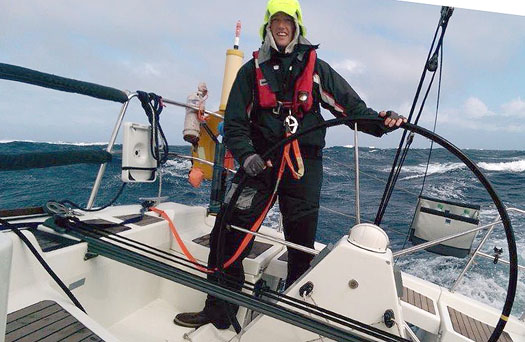
Speed at sea – Brian Flahive on the wheel as Lula Belle puts in the kind of sailing which knocked off 200 miles a day. Photo: Liam Coyne
But they blasted on, roaring on a reach up through the North Sea with Lula Belle doing mighty well, as the more extreme boats such as their closest rival, the Figaro II Rare, weren't quite getting the conditions to enable them to fly, whereas old Lula Belle was knocking off 200 miles in every 24 and saving her time very nicely.
North of the English/Scottish border, the strong winds drew ahead. The forecast, however, was for westerlies, so some boats in front laid markedly to the westward looking for them. But Coyne and Flahive sailed a canny race. What they knew of the weather maps suggested very slow-moving and messy weather systems with lots of wind. And from ahead. They reckoned the prospect of westerlies was just too good to be true. And they were right. On the entire leg up to Muckle Flugga, the most northerly turn, they never strayed more than five or six miles from the rhumb line, and thus they sailed the absolute minimum distance, albeit in very anti-social conditions, to get to the big turn.
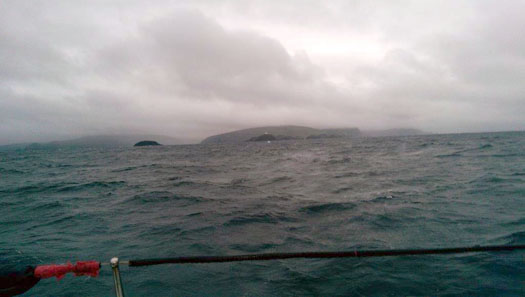
The sunless sea, with Lula Belle getting past Muckle Flugga on Shetland, the northerly turning point of the RB & I Race, and the sky promising plenty of wind Photo: Liam Coyne
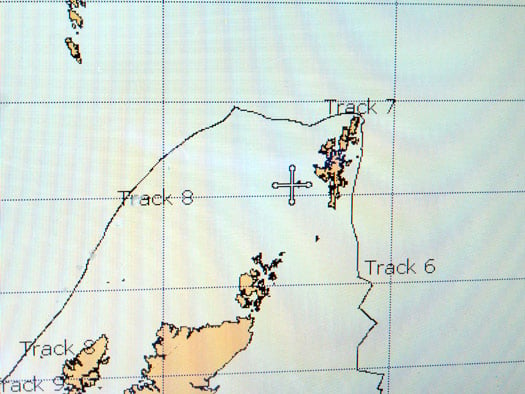
The win move. Although Lula Belle had taken a conservative route northward, once they'd rounded Muckle Flugga they took a flyer to try to get on the favoured side of a slow-moving yet very intense low. The plan succeeded, but they'd to go almost halfway to the Faroes for it to work. Photo: W M Nixon
By this time the faster boats had got back into a substantial lead, but here the situation suited the Irish duo. Those in front went battering and tacking into a fierce sou'wester, trying to get nearer the next turn at St Kilda. But the Irish boat's cunning scheme was to slug directly westward once they'd rounded Muckle Flugga, and not tack until they'd some real prospect of being in the harsh northerlies which they knew to be somewhere out beyond the very slow-moving low pressure area.
Thus they ended up midway between the Shetlands and Orkney to the southeast, and the Faroes to the northwest. As Liam Coyne drily puts it: "When you take a flyer like this and it works, it isn't a flyer any more – on the contrary, it's the only way". What they didn't know was that the boats trying to batter their way past the Outer Hebrides and down towards St Kilda had taken such a pasting that their immediate rival Rare had made a pit stop to rest up in the Shetlands, and others dropped out "for a while" only to find it had become a matter of retiring from the race.
But Lula Belle, having cast the dice to go west, had no option but to keep going, as she was nearly 50 miles west of the Rhumb Line, and more a day's fast sailing from any shelter. By this time, the Scottish forecasters had up-graded their gale warnings to severe storm Force 10. But thanks to their pluck in going west, Coyne and Flahive were up towards the northwest corner of the low, whereas the opposition were down in the southeast quadrant where the winds are usually significantly stronger.
Nevertheless at the change of the watch they shortened sail to the three-reefed main and the storm jib, even though the wind had fallen right away. Brian went off watch and then returned on deck after some sleep to find Liam had become becalmed, and had been so for some time. The centre of the low was passing straight over them. Now it was only a matter of time before the new wind came out of the north.
When it did it was nasty and cold, and the sea became diabolically rough and confused. But it was a fair wind, and they made on as best they could through the short northern night to close in on St Kilda. It was sunrise when they went past that lonely sentinel, and for once there was briefly sunshine to prove it, but it was watery bad weather sunshine as they settled in for the long haul to Ireland.
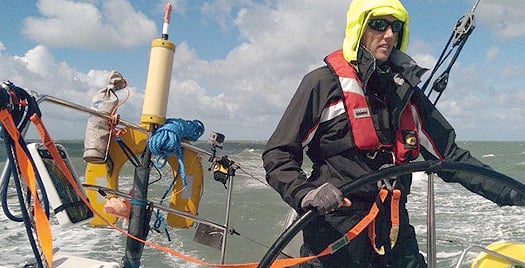
A great fair wind at last, but it was so very very cold despite some sunshine. Photo: Liam Coyne

Early morning as they pass St Kilda, with Lula Belle well placed in the race and her closest but higher-rated rivals astern. Photo: Iiam Coyne
By this stage the boat was very much their home, and they were both in good spirits. Despite the expectation of being in race mode for at least ten days and probably much more, they hadn't anything too much in the way of special easy-made instant food. When asked who had organized their stores and how they had been procured, Liam responded: "I just went to Tesco before the race, and filled her up. It's very easy when you've only two. I've had to do the stores for the boat with a crew of eight, and it's a pain in the neck".

Getting an omelette just right is tricky at the best of times, yet this masterpiece was created aboard Lula Belle off the coast of Donegal in 30 knots of wind. Photo: Liam Coyne
As for living aboard, they used the two aft cabins for sleeping, with hot bunking dictated by which was the weather side. In cruising mode, the First 36.7 is a very comfortable boat, but in racing things tend to get put behind the lee-cloth on the weather settee berth in the saloon, for the fact is the boat is designed to be raced with a crew of 7 or 8, and she tends to be a bit tender without six bodies on the weather rail.

Post-return temporary disorder in Lula Belle's saloon on her arrival back in Dun Laoghaire after sailing nearly 3000 miles in all since she'd last been in her home port. Though Brian (left) and Liam used the aft cabins for the short off-watch periods of sleep, the lee cloths on the settee berths were kept up to provide ready stowage for loose gear, preferably on the weather side. Photo: W M Nixon

Having the toilet on the fore-and-aft axis is very convenient at sea. And having an "extra-easy-cleaned" compartment is a real boon for hygienc. As for the funnel and hose, that's essential in a men-only boat in racing mode. Photo: W M Nixon
To my mind, one of the best things about the accommodation is the heads (toilet if you prefer). Some folk might think the compartment is too compact, but the loo is aligned fore and aft, so there simply isn't the room to fall about when using it. With the fore and aft alignment, security and comfort is guaranteed at those special private moments. It should be a law of yacht design that any boat which is going to be taken further than half a mile offshore is designed with a fore and aft loo.
Such thoughts would not have been forefront in the minds of Lula Belle's crew as they set the A3 spinnaker for the long run to Black Rock off the Mayo coast. Inexplicably, and as evidence of their stretched shoreside management support arrangements, they'd failed to bring along a new Code Zero spinnaker from sailmaker Des McWilliam. They'd gone for it despite it putting three extra notches on their rating, but it was nowhere to be found. After the race, it was discovered among a pile of 20 sails in Liam's Dublin office. But out in the lonely ocean southwest of St Kilda, it wasn't there when it was needed.
Yet it was soon needed even more. The smaller sail that was put up simply disintegrated after a brief period of use. It was inexplicable, but reasons weren't important just then, they were now down to just two spinnakers, and a very long way to go downwind to the finish.
So they nervously got out the A4, and soon it was up and drawing and Lula Belle was back in business, sailing fast for Ireland. Liam went below for a much-needed kip, and a sudden squall over-powered the boat. By the time he got back on deck she'd broached completely and the sail was shredded. They were down to just one spinnaker, and one in very dodgy condition at that. To add to their joys, in a crash gybe the mainsheet carriage disintegrated and they'd "ball bearings, it seemed like hundreds of them, all over the place...."
So there they'd been, passing St Kilda and knowing that, despite the lack of sailing instruments, they couldn't have done the leg from Shetland any better, and more importantly knowing from Yellowbrick that Rare was now well astern. Yet here they were now, only a few hours on the way, and they were down to one spinnaker and a jury-rigged mainsheet arrangement and a long way to go and the weather starting to suit Rare. Could it get any worse?
It did. Approaching the Blaskets, as usual the ship's batteries were draining with unreasonable speed. But the engine, when called upon, was dead. Dead as a dodo. It turned over but just wouldn't start. They knew that in very short order they'd be even further cut off from the outside world than they were already, with no chart plotter and without even the comfort of Yellowbrick to tell them how they stood in relation to the opposition. No autohelm whatever, either. And they'd 495 miles still to sail.
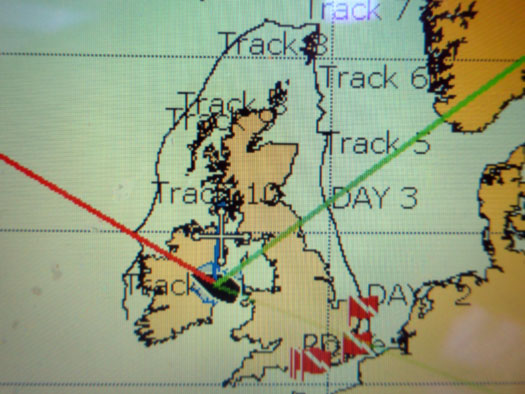
Moment of truth. The chart plotter's power dies just north of the Blaskets, the most westerly point of the 1802-mile course. Photo: W M Nixon

Getting on with it. Just south of the Blaskets, Brian goes aloft to try and clear the constantly-jamming Windex. Photo: W M Nixon
So they picked themeselves up, dusted themselves off, and started all over again. Brian went aloft to the waving masthead to free the Windex, which was in its jamming mood. Then progress was good heading down towards the Isle of Scilly. But even so, midway across, alone at the helm and steering and steering and steering, Liam admits to a very low moment.
They were now almost midway between Cowes and Dun Laoghaire, So he thought to himself: Why not just turn to port and head for home? Head for that comfortable NG34 berth in Dun Laoghaire marina, instead of struggling on with sails which were bound to shred even further, and leave them eventually straggling across the line completely dog last and with everything to fix, and then they'd have to turn round and plug into the early Autumn gales all the way back round Land's End to Dun Laoghaire?
And what then? he thought. Well, then in four years times we'll have to do the damned thing all over again. All, all, over again. So we'll just finish the bloody thing now, and get the T-Shirt, and that will be that regardless of how far we're placed behind everyone else, and good riddance to it all.
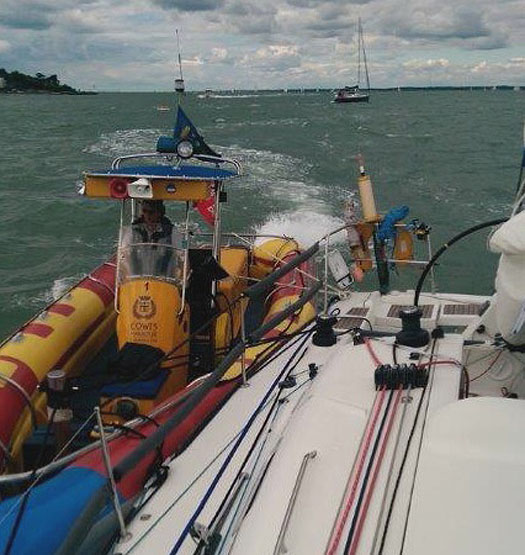
Welcome back. Knowing of Lula Belle's engine-less plight, the Cowes harbourmaster made sure they were brought into their Berth of Honour in style. Photo: Liam Coyne
So they stuck at it, they nursed the boat through the shipping separation zones at the Scillies without the spinnaker up because they knew the multiple gybing would destroy it, then as Rare didn't get past them until this stage, they knew that after such a long race she'd need to be 22 hours ahead at the finish and that was surely impossible. They were very much in with a shout of being better than last, so they nursed that mangled old spinnaker right up the English Channel (Mother Flahive's emergency sewing machine had done some marvellous repairs), and maybe the spreader ends were now showing out through the mainsail again, but what the hell, they got in round St Catherine's point and shaped their way back into the eastern Solent and on up to Cowes, and didn't Rare's crew and various bigwigs come out to tow them into port and confirm to them that they had indeed been there, they'd seen it, they'd done it, they'd won it., and now they could get the T-shirt.

Been there, seen it, done it, won it, got the T-shirt.....Liam Coyne back at the bar of the National YC five days after winning the two-handed division and two RORC classes in the 1802-mile Seven Stars Round Britain & Ireland Race 2014, and with his boat Lula Belle safely returned to her home port of Dun Laoghaire. Photo: W M Nixon
Tsunami Takes Penultimate ISORA Race Win
#isora – This ISORA season was definitely a season of two halves – heavy weather during the first half and very light weather during the second half writes Peter Ryan, ISORA commodore. As so it was for the Race 9 that was originally scheduled to visit the M2 Weather buoy. Traditionally our dominant south westerly winds usually give the desired beat and run but this year was different. North west winds were forecast. Not only that, while there was plenty of wind at the briefing at 08.45, the forecast was to drop to little or nothing at 14.00.
In light of this the Sailing Committee decided that leaving the ISORA fleet bobbing in the middle of the Irish Sea was not to anyone's advantage and re-set the course. The fleet were to head out of Dublin Bay to Bennet Buoy and from there to Taylor's Rock just north of Lambay, leaving Lambay to starboard. The return course was back to Bennet and to the Finish – 38 miles.
With the wind forecast this would produce a beat to Taylor's Rock and a badly needed "J109 knobbling" run back to Bennet. Well it nearly worked out. NYC Commodore, Larry Power sent the fleet of 11 starters reaching off towards Bennet under spinnaker in up to 20 knots of wind at 10:00. The whole fleet soon arrived at it but the wind had started to decrease. "Ruth" was first around followed quickly by "Tsunami", "Axiom" and ""Adelie".
Soon after the entire fleet rounded and were set on the beat to Taylor's Rock the wind dropped and started to back and veer, by up to 50 degrees. With boats back to their number No1's the tactic was to spot the continuous shifts and tack accordingly. The closer the fleet got to Lambay, the more critical this was. "Tsunami" appeared to maximise this and broke away from the fleet rounding Taylor's Rock with a huge lead. "Bag Up" and off they headed to romp home, they thought!!
Very soon after passing the perch at the end of Lambay the North West wind back westerly and then south west before disappearing. "Tsunami" sat in the hole watching the fleet approach them. Hard work by the "Tsunami" crew drove the boat to eventually break through the hole and emerge on the other side into a South Easterly breeze that took them on a beat towards Bennet will the ebbing tide.
The hole in the wind between the north westerly on one side and the south easterly on the other could be clearly seen. It did not move. The following fleet appeared to try and skirt around the hole by heading in towards Howth only to find that the hole extended into the shore!!!
While "Tsunami" beat towards the Bennet in a light breeze, the remainder of the fleet struggled with many retiring at this point. By the time "Tsunami" reached Bennet the tide had just started to head north making the problem for the following boats even greater. At the Bennet ,"Tsunami"'s lead had extended to approximately an hour ahead of "Ruth".
"Tsunami" headed towards the finish in a southerly breeze that got very fickle as they entered into the Bay. Close to the finish the light wind shifted again back to the north west but "Tsunami" was able to cross the line and be greeted by ISORA Finisher, Katheryn Meghan, at 19:06.
Only four boats managed to get to the finish with "Ruth" arriving over two hours after "Tsunami" and the last boat, Pippa IV, crossed the line at 01:23. "Tsunami" took Overall and Class 1 while Pippa IV took Class 2 and Silver Class.
The next race is the last one and takes place on the 6th September – "James Eadie Race" from Pwllheli to Dun Laoghaire. This is always a very popular race and I hope as many boats as possible will support it. There will be the usual Crew Bus to meet the ferry on Friday afternoon in Holyhead and there are plans afoot to have a finishing party in the NYC, if weather permits.
I am pleased to announce that "Hendrick Ryan + Associates", Consulting Structural Engineers, have agreed to sponsor the last race. The title of the race will be the "HR+A James Eadie Race". I am looking for other sponsors of Races and / or Series for next season.
Finally, I have to congratulate our "ISORA brothers" Liam Coyne and Brian Flahive in "Lula Belle" who did extraordinarily well in the recent "Round Britain & Ireland Race". It was some epic feat and I hope that both will share their experiences with us by giving a talk.
ISORA Races Both Sides of Irish Sea This Friday Night
#isora – There are two ISORA night races scheduled for this Friday night one on either side of the Irish Sea. The Dun Laoghaire Night Race (ISORA - Race 8a) is organised by the National Yacht Club in conjunction with the Royal Alfred Yacht Club Offshore Series. On the Welsh side, the Pwllheli Night Race (ISORA - Race 8b) is organised by Clwb Hwylio, Pwllheli Sailing Club.
Sailing Instructions for both races are attached.
#isora – The weather forecast was depressing for ISORA's 2014 KONA Offshore Perpetual Trophy Race on Saturday 26th July from Dun Laoghaire to Pwllheli writes Peter Ryan. The only conversation during the pre-race get together in the NYC on the previous evening was "how can any boat manage to get to Pwllheli with that forecast?" The ISORA Sailing Committee decided after extensive deliberations to shorten the course to go direct to Pwllheli.
All the forecast for the entire week prior to the race was predicting little or no winds for the entire weekend. As the week went on, a small glimmer of hope started to appear that there would be some freshening of the condition late on Saturday evening.
The weather forecast appeared to deter those boats whose crew had anything planned for the following day and early into that week? Of the 19 entries for the race 12 came to the start line. As a fitting reward for those who race offshore the Gods provided 5 knots of and easterly breeze to help the fleet out of Dublin Bay. At the time of the start line there was a strong flooding tide pushing the boats away from the line. Eventually all boats crossed and the "Starter", NYC Commodore, Larry Power could stand down.
The route from the start was a beat out of Dublin Bay. The winds were very fickle as the fleet beat their way against a strong tide towards the Muglins. "Sgrech" was to first boat to draw blood by negiotiating the fickle winds and taking an inside route to avoid the tide emerged to be the first boat out of Dublin Bay. Even at that stage the entire fleet was spread in the north south line leaving across most of the mouth of the bay.
After that, I have absolutely no idea what happened!!!
Some of the fleet appeared to take a southern route, beating towards Bardsey while other found themselves heading north being taken by the tide. There was little or no wind anywhere. The wind rose and fell all through the day with progress being made when the wind was there and the boats drifting back when the wind fell. There were times when one could view the sea conditions from Wicklow head to Howth head and there was not a wisp of wind around. Despite the clear conditions the fleet dispersed and only immediately adjacent boats were visible.
Leader out of the Bay, "Sgrech" took a southerly path with fellow J109s, "Mojito" and "Jetstream" and "Adelie" following. "First of September" was there also but taking a midway route. Current holder of the KONA trophy "Ruth" and "Jackknife 2" tacked out and disappeared, not to be seen again.
It was a long frustrating day with the wind rising and falling, veering and backing, jibs and spinnakers and anchors up and down. And then came the night!!! With a clear sky and a most wondrous display of stars, masthead lights started appear as the fleet neared Bardsey. By this time the tide was ebbing and all baost took the route through the Bardsey Sound.
"Ruth" took a huge lead and finished with line honours miles in front of the "Jackknife 2". Next over was "First of September" and "Sgrech" followed immediately by the Class 2 Sigma 33 "Elandra". "Mojito" was next to cross the line in dying wind conditions for the ISORA finisher and ISORA Vice Chairman, Gerry Williams. The last boat finished after 10.00 on Sunday morning.
"Ruth" took the Overall win and retained the KONA Offshore Perpetual Trophy and also tool Class 1. "Elandra" after sailing a great race took Class 2 and Silver Class.
Pwllheli Sailing Club who had been expecting the fleet in the previous evening had breakfast and refreshments available for all the finishers. All boats finishing were welcomed with much appreciated refreshments served from a PCS inflatable.
The race Sponsors KONA have created a photographic competition where all photographs taken during the race will be judged. All entries should be emailed to [email protected] and also copied to me [email protected] . All entries will also be posted on the ISORA website picture gallery.
At this stage in the Series "Ruth" is in a commanding lead and only needs to take care during the last three races to win the coveted "Wolf's Head Trophy".
They will be mindful of this position after their experience in the last race when "Sgrech" overtook them within 3 miles of the finish of the last race to steal the Series from them. "Ruth" will be hungry for success after also being robbed of the Round Ireland Race win when within 10 miles of the finish.
The next race is the ISORA RAYC Night Race on Friday 8th August. This is always a popular race with the course heading south around North India and along the well lit Wicklow coastline.
#isora – Race 7 of the ISORA series takes place tomorrow with the race from Dun Laoghaire to Pwllheli. This race is being sponsored by KONA and is also the feeder race to the Welsh IRC Championships to take place in Pwllheli on the following weekend.
A fleet of 17-18 boats are expected to take part in the race. How the fleet handles the forecast light winds in the early morning could be the deciding factor in the overall placing. "Ruth", who came second in the recent Round Ireland race will be taking part. He is also leading the Overall ISORA Series and needs a good result in this second last offshore to ensure his placing.
KONA are presenting their KONA Offshore Perpetual Trophy for the race. Coincidentally "Ruth" won this event last year. As it is the feeder race to the Pwllheli event the Royal Dee Yacht Club is also presenting their Tidal Cup to the overall winner. The winner of this race will collect three trophies.
It is hope that many of the ISORA boats will take part in the IRC Championship. Many of them took part in the recent ICRA Nationals. ICRA are presenting a trophy to the boat with the highest combined points in both events. This is an innovative idea to further develop the relationships between both sides of the Irish Sea. Pwllheli are in an advanced stage of construction of their Sailing Academy and are likely to be a dominant player the sailing in the Irish Sea. The first part of this work - the 40 dedicated racing berths on the marina will be available for the ISORA finishers this weekend.




























